Teaching _Romeo and Juliet_ by William Shakespeare: Integrating Music, Art, & Analysis
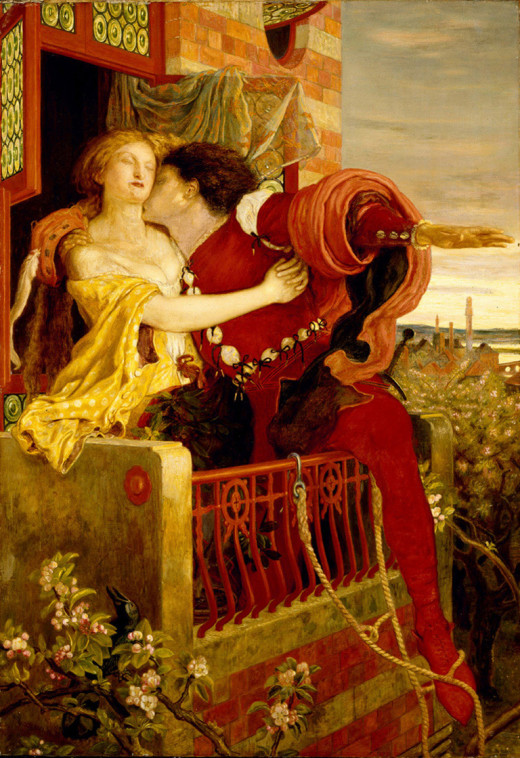
- Romeo and Juliet: Romeo and Juliet Play Summary & Study Guide | CliffsNotes Shakespeare Central
CliffsNotes' offers an extensive summary and study guide. - Interactive Folio : Romeo and Juliet
The Interactive Folio provides a lot of multimedia resources to enhance reading of the play. - No Fear Shakespeare: Romeo and Juliet
No Fear Shakespeare by SparkNotes features the complete edition of Romeo and Juliet side-by-side with an accessible, plain English translation.
Teaching Romeo and Juliet by William Shakespeare
Teaching the works of Shakespeare can be taxing, exhausting, and frustrating, especially when you want your students to cultivate an appreciation of Shakespeare's language. Sometimes they feel as though they're just not "getting it". This hub offers some ideas and resources to help make Romeo and Juliet fun for you to teach and your students to learn.
One of the first hurdles is Shakespeare's language. Along with his stories, Shakespeare's language is what makes his works truly special, but it can be difficult for even some of the strongest readers in your classroom. Here's a couple of resources about reading Shakespeare:
- Reading Shakespeare's Language (Document create by Cal State ELA Dept.)
- How to Understand Shakespeare is a nicely written hub on the subject
- Bardweb.net offers several resources and links related to Shakespeare's use of language.
I believe it's important to perform Shakespeare in the classroom. Students can often overcome their difficulties with the language once they're hooked by the story and become accustomed to the way that the characters speak. Still, your classroom performance of the play must be balanced with lots of guidance from the instructor. It's okay to stop and explain what's happening or some dense figurative language, and most textbooks come with helpful footnotes for teachers and students. The use of props (I love using foam swords for the fight scenes) can also make the play seem more like an interactive experience than a passive "sit-and-read-aloud" exercise.
Also, remind students to remember that no one really knows EXACTLY how Shakespeare intended every line to be read or performed. Every new staging of Shakespeare lends its own twist. There's no "one right way" to interpret or perform Shakespeare. For instance, consider Shakespeare's love of puns. Many lines and words within lines can be interpreted multiple ways. Your brain is constantly looking for and finding new ways to consider every line and every word. That's exactly what he wants-- to keep his audience on its toes for the duration of his plays.
Romeo and Juliet Analysis: What is Love?
CCSS RL.9.4: Determine the meaning of words and phrases as they are used in the text, including figurative and connotative meanings; analyze the cumulative impact of specific word choices on meaning and tone (e.g., how the language evokes a sense of time and place; how it sets a formal or informal tone).
Length: One class period.
Students are usually surprised by the ages of Romeo and Juliet (Juliet is not quite fourteen in the play.) and the characters' declarations of love within hours of meeting one another. Romeo's professions seem especially suspicions, since he'd been declaring his undying love for Rosaline early that day and claims that he wants his eyes to "be burnt for liars" if he ever sees anyone more fair than her. Of course, as soon as Romeo sees Juliet, he quickly changes his tune and says, "forswear it, sight! / For I ne'er saw true beauty till this night."
As a class, we decide that to answer the question, "Are Romeo and Juliet truly in love?", we must first agree on a definition of love. I begin class with a journal. Students read the following quotes, explain what each means, agree or disagree with each quote, and try to connect it to a character or event from Romeo and Juliet (We usually do this exercise after Act I or Act II, scene II.):
- "Love is composed of a single soul inhabiting two bodies. --Aristotle
- "Love is friendship that has caught fire." --Ann Landers
- "Immature love says: 'I love you because I need you.' Mature love says: 'I need you because I love you.’" --Erich Fromm
After a discussion, I ask students to define "love". They look up the word in the dictionary and write down the dictionary definition.
Then students have to elaborate on the denotative meaning. They are to explain what love is in their own words with a short paragraph. Some kids will write a ton; some will write very little. After a few minutes, we briefly discuss and talk about the connotations associated with "love" beyond the dictionary definition.
Students then make two columns beneath the dictionary definition and their explanation of "love". The columns are labeled "Examples" and "Nonexamples". In small groups, students come up with at least five examples of "what love is" and five examples of "what love isn't". I make a chart on the Smartboard, and students share answers as a class. Usually, this makes for an interesting discussion which you will probably have to cut short.
For closure to the lesson, students should create a visual representation (a symbol) representing the definition of "love". THEY CANNOT USE HEARTS! Really, they shouldn't use ANY pre-existing symbols. I have students draft their symbols on paper first and then draw them on butcher paper located on a classroom wall. If time allows, we discuss some of their symbols.
We reference these symbols and definitions of "love" throughout the reading of the play and especially as we continually discuss, "Are Romeo and Juliet truly in love?"
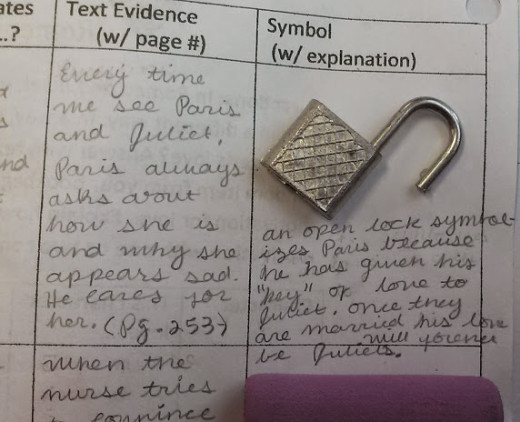
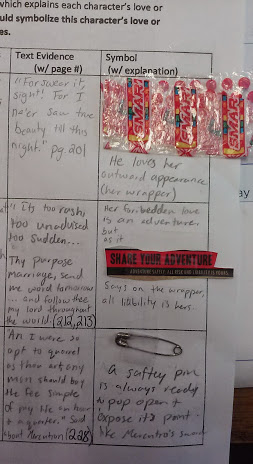
Metaphorical Thinking: Create a Character Motivation Chart w/ Backpack Junk
CCSS 9.RL.3: Analyze how complex characters (e.g., those with multiple or conflicting motivations) develop over the course of a text, interact with other characters, and advance the plot or develop the theme.
Length: 30-45 minutes (but they will take as long as you give them)
The purpose of this assignment is for students to analyze how "love" motivates the characters of Romeo and Juliet in some fashion or another. Even Tybalt could be said to be motivated by love, his love of violence.
Students analyze what each character loves; what motivates his or her love; cites text evidence to support their claim(s); and then creates a symbol which represents this character's motivation or love.
The symbol part is where things get fun. Students are limited to use of objects in their pockets or their own bags to use as symbols on this chart. The object must be small enough to fit on the chart, and students must explain how this object symbolizes each character's motivation. Students have used opposite sides of pennies as symbols for foils, and one used a tiny empty bag as symbol of Paris being left "empty-handed". Not every object or symbol works perfectly, but you have to give students props (pun-intended) for getting creative with their objects.
I've linked a copy of the chart I use in Microsoft Word format, so you can download and tweak it.
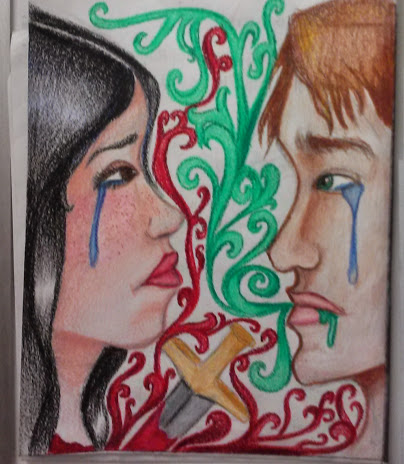
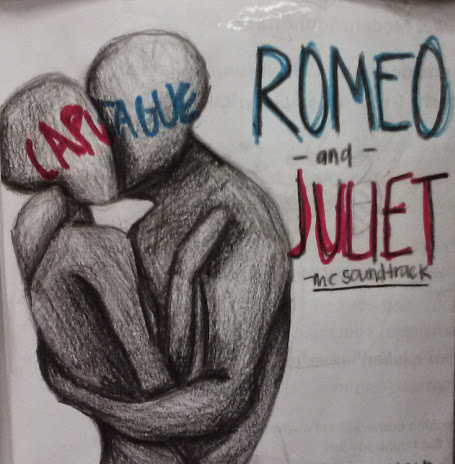
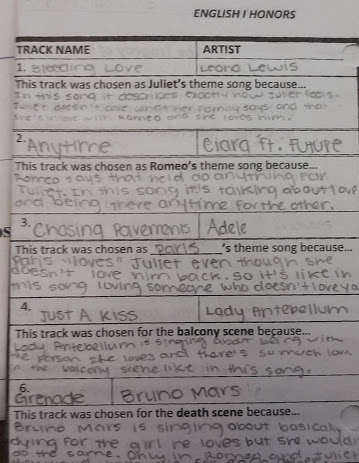
Art & Music: Create an Original Soundtrack
CCSS RL.2: Determine a theme or central idea of a text and analyze in detail its development over the course of the text, including how it emerges and is shaped and refined by specific details; provide an objective summary of the text.
CCSS RL.3: Analyze how complex characters (e.g., those with multiple or conflicting motivations) develop over the course of a text, interact with other characters, and advance the plot or develop the theme.
Length: I assign this as homework and give students a week.
First, I share some elements of the soundtrack for the 1996 version of Romeo and Juliet with students. I ask them to consider the soundtrack choices made for the 1996 version and to notice the names of the tracks or sample lyrics and think how they might relate to Romeo and Juliet.
For this assignment, students are asked to create a new soundtrack for Romeo and Juliet, focusing on specific characters and scenes. In the “liner notes” of the soundtrack cover, students must explain why they chose the song for each particular character or key scene with complete sentences. Students must use REAL, EXISTING songs and must know the artist and title of the song. Students should be familiar enough with the lyrics to specifically reference them in your liner notes.
You can prep students for this assignment by playing Daylight by Maroon 5 (get a copy of the lyrics or play a version which shows the lyrics) and having students journal and/or discuss how the song would be a good fit for Act III, scene 5 (the second balcony scene).
Students then create a mock CD cover for your soundtrack. The mock CD cover should symbolize the themes of Romeo and Juliet and not simply be a depiction of an event or character of the play. On the inside of the cover, students explain their visual depiction of the play’s themes with complete sentences.
After students submit this assignment, I take some of their song choices and create a Romeo and Juliet soundtrack playlist which I play during group work. Here is the link for the 2015 playlist on Spotify.
Here is a copy of the template I use for this assignment in Microsoft Word for downloading and tweaking.
The Blame Game
Which character(s) are most to blame for the deaths of Romeo and Juliet?
Romeo and Juliet Analysis: Who is to Blame for Romeo's and Juliet's Deaths?
CCSS 9.RL.1: Cite strong and thorough textual evidence to support analysis of what the text says explicitly as well as inferences drawn from the text.
Like "Are Romeo and Juliet truly in love?", the question of blame is one that is great for students to discuss in Socratic Seminar format or to write an argumentative essay.
Length: Four Corners Activity lasts about 15-20 minutes.
If you've read the play, then the process of answering the question is fairly easy, but you probably need to establish some ground rules. For instance, will you allow your students to blame Romeo and Juliet for their own deaths? I approach the question from Prince Escalus' perspective. At the end of the play, Escalus says some will be pardoned and some will be punished. WHO will Escalus punish for their role in Romeo and Juliet's deaths? You may even want to go so far as to focus students on specific excerpts of the text or certain characters before giving them "free reign".
Before writing the essay, I like to do a four corners exercise. Typically, we have focused on three parties: the parents, Friar Laurence, and Fate. The fourth corner is marked "Other/Undecided".
Here are the directions I post (one-by-one) on my Smartboard:
- Find the character you think is most responsible on the wall and stand under it.
- You have two minutes to discuss as a group why this character is most responsible. Choose a speaker to state your points to the class.
- Now you have a minute to respond to each other’s statements. Explain why your character is more responsible than others’ through your rebuttal. A different speaker should state your points to the class.
- Now use TEXT EVIDENCE ONLY to prove your points. What evidence from the play supports your character as the most responsible for Romeo and Juliet’s deaths? A different speaker should state your points to the class.
After this exercise, I tell students that they have heard the evidence and argument which should compose the meat of their essay. We typically draft on the following day.
Performance: Rewrite a Scene for a Different Genre
One of the last things we do is (in groups) to choose a scene from Romeo and Juliet and rewriting it for a new genre with modern language. Most teachers do some version of this for the simple reason that it's FUN! It also makes students closely read the text to update events and specific lines of dialogue.
Here are the instructions I give to students:
- Choose a scene (any scene!) from Romeo and Juliet to rewrite.
- Choose a new genre for this scene (western, sci-fi, slapstick comedy, rom-com, kung-fu, horror, etc.)
- You can’t change character’s names or what happens in the scene. Go line-by-line and simply update it for your genre.
- Rewrite the scene in the form of this genre, updating the dialogue for the characters in the scene. Find a way for every member to participate.
- For instance, imagine Act III, scene I (Tybalt’s and Mercutio’s death scene) as a western with cowboys dueling at high noon and talking with Western accents. Or imagine the ACT II, scene II balcony scene as a corny teenage CW soap opera with modern dialogue.
Re-Write Rubric
Category
| 5-4 Points
| 3-2 Points
| 1-0 Points
|
|---|---|---|---|
Content
| The scene was true to the original play in content (characters and events) while updating aspects based on chosen genre. Students effectively changed dialogue to modern language (while also matching genre).
| The scene was mostly true to the original play in content. It may have left out key elements or lines of dialogue. The scene and its dialogue was updated satisfactorily based on genre.
| The scene departed drastically from the original play, either adding new content or deleting too much of Shakespeare’s original content. The students did not effectively update the scene for genre or changing dialogue.
|
Characterization
| The scene kept all original characters and stayed true to their characterizations while updating the characters based on genre.
| The scene perhaps left out a key character or changed the characterization of a character from the play.
| The scene left out key characters or the characters drastically changed in personality or action from the original play.
|
Originality
| The students presented a new interpretation of Shakespeare’s play while cleverly updating aspects for a new genre and modern language.
| The students presented a somewhat new interpretation of Shakespeare’s play, but elements are based upon existing films, television shows, books, or other existing interpretations of the play.
| The students did not use an original idea or add a new twist when updating either the scene or the language of Shakespeare’s play.
|
Length
| When performed, the scene is at least three minutes in length.
| When performed, the scene is at least two and a half minutes in length.
| When performed, the scene is less than two minutes in length.
|
Collaboration / Participation
| Students effectively used classroom time and every member of the group participated in the writing and the performing of the scene.
| Students mostly used classroom time effectively and every member of the group participated in the writing and the performing of the scene.
| One or more members of the group did not make effective use of classroom time or did not participate in the writing or performance of the scene.
|
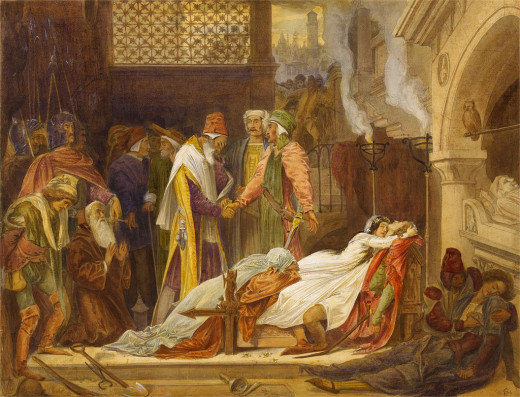
Just For Fun: Online Shakespeare Games/Entertainment for Students
- 'Speare
Arcade game based upon elements of Romeo and Juliet. - Shakespeare Games
Home of the Modern Library, renowned publisher of classics, chronicles, essential writings, and translations. Includes the Bantam Classics line of titles for high school and college students, and the authorized Royal Shakespeare Company editions. - Shakespearean Insulter
This randomly generates all of Shakespeare's best insults (from his plays, obviously). - Romeo and Juliet Jeopardy Jeopardy Template
Template for a Jeopardy Review game of the play. - Shakespeare Games @ Just For Kids
Interactive games and learning. - Romeo - Play Free Kids Games Online
In this adventure platform game, you have to help Romeo find his way through Shakespeare Country to rescue Juliet from the balcony! Collect all the roses and watch out for those critters.


![William Shakespeare's Romeo + Juliet: Music From The Motion Picture (1996 Version) [Enhanced CD]](https://m.media-amazon.com/images/I/61EGFsloDNL._SL160_.jpg)


